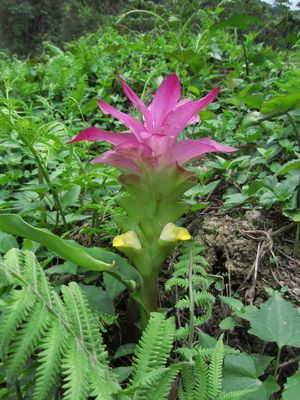Note: This is a project under development. The articles on this wiki are just being initiated and broadly incomplete. You can Help creating new pages.
Difference between revisions of "Curcuma aromatica - Wild turmeric, Aranyaharidra"
Chaithrika (talk | contribs) (+Common names) |
Chaithrika (talk | contribs) m (Chaithrika moved page Kasthuri arishina to Aranyaharidra: renaming as per convention) |
(No difference)
| |
Revision as of 15:52, 3 March 2017
Kasthuri arishina (common name: wild turmeric) is a member of the Curcuma genus belonging to the family Zingiberaceae. Botanically close to Curcuma australasica, wild turmeric has been widely used as a cosmetic herbal in South Asia and nearby regions.
Contents
Description
The wild ginger is one among the 80 members of Zingiberaceae family of plants. The perennial foliage dies down in late autumn and the rhizomes remain dormant in winter. The inflorescence appears in early spring from the base of the rhizomes. During summer monsoon season and the immediately following weeks, the plant grows fast and vigorously. The stalk grows to about 20–30 centimetres (7.9–11.8 in) tall, and is crowned with enlarged coloured bracts with pink tips. Leaves often appear even after the flowers. When in full growth the plants can reach a height of about40 cm (16 in) tall.
Uses
Wild turmeric has rhizomes with a peculiar fragrance and cream color. The rhizomes are often used in cosmetic herbal medicines and as a culinary ingredient in limited quantities as a food flavor. Leaves are broad and very decorative, elliptic with a leaf stem running as long to the tip of the blade. A fresh stalk with flowers and leaves, cut to proper size and shape, can be used as a floral indoor decoration in vase for up to 10 days.
Common name
- English - wild turmeric
- Kannada - ಕಸ್ತೂರಿ ಅರಿಶಿಣ
- Hindi - जंगली हल्दी
